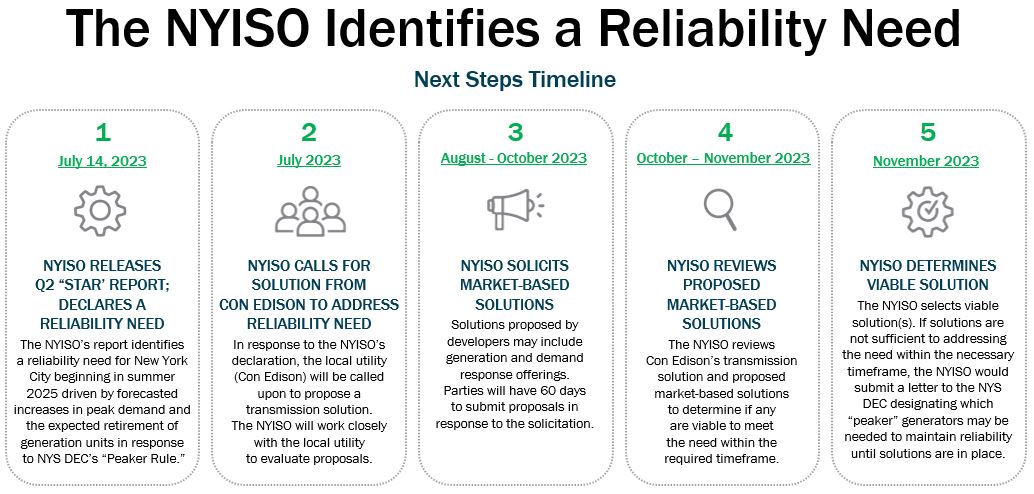Reliability Planning Process and Declaring a Reliability Need: Next Steps

On July 14, 2023, the New York ISO issued its Short-Term Assessment of Reliability for the second quarter of 2023 (Q2 STAR). The Q2 STAR assessed conditions on the bulk electric system in New York over a five-year study period of April 15, 2023, through April 15, 2028, considering forecasts of peak power demand, planned upgrades to the transmission system, and changes to the generation mix over the next five years.
The NYISO’s Comprehensive Reliability Planning Process includes biennial reliability planning reports focused on identifying and resolving reliability needs with longer lead times through the Reliability Needs Assessment (RNA) and the Comprehensive Reliability Plan (CRP). Anticipating that the pace of change on the grid was increasing, in 2019 the NYISO established a quarterly Short-Term Reliability Process (STRP) in its federally regulated tariffs. Through the STRP, each quarter the NYISO identifies reliability needs that may arise over the next five years due to various changes to the grid such as generator deactivations, revised transmission plans, or updated electricity demand forecasts. Should a reliability need be identified in a STAR, the NYISO solicits for and selects solutions to address the need.
In the Q2 STAR the NYISO identified a reliability need in 2025 within New York City based on the deficient transmission security margin. Transmission security analysis tests the grid’s ability to withstand disturbances, such as electric short-circuits or unanticipated loss of system elements (such as a generator or a transmission line) that can place at risk the grid’s ability to safely and reliably deliver electricity from where it is produced to where it is consumed.
The Q2 STAR found that, under expected weather conditions, the New York City zone is deficient by as much as 446 MW for a duration of nine hours on the peak day during expected weather conditions when accounting for forecasted economic growth and policy-driven increases in demand. Extreme weather, which is often accompanied by increased demand for electricity, further adds to the risk of outages.
The reliability deficiency reflects both increased demand for electricity and the impacts of the 2025 implementation of the New York State Department of Environmental Conservation (DEC)’s “Peaker Rule” which limits nitrogen oxide (NOx) emissions from generators that are able to start-up quickly to address “peak” electric demand. The first stage of implementation of that rule took place on May 1, 2023, when 1,027 MW of affected peaker generators either deactivated or limited their operations. The NYISO considers generators’ Peaker Rule compliance plans in its reliability planning processes. No reliability need was identified with 2023 operations stemming from the Peaker Rule. An additional 590 MW of peaking generators are expected to become unavailable beginning May 1, 2025, when the second phase of the Peaker Rule takes effect. All of the affected generators are located in New York City.
Reliability rules detailed in its tariffs define the course of action the NYISO must follow when a reliability need is identified. To address the identified need, the NYISO solicits and evaluates solutions in accordance with its tariffs. Since the need arises within the Con Edison Transmission District in New York City, Con Edison must propose a backstop solution to the need. Beginning in August, the NYISO will solicit the backstop solution from Con Edison as well as market-based solutions from other developers. Developers may offer supply or demand response solutions which may include generation, storage, and/or new participation in programs that act to reduce demand on the grid. Parties will have 60 days from the issuance of the NYISO’s solicitation to proposed solutions.

In October and November, after the solicitation window has closed, the NYISO will evaluate the proposed solutions it receives to determine if they are viable and sufficient to address the identified need. This process requires NYISO planners to comply with strict reliability rules and processes that are detailed in the NYISO’s federally regulated tariffs to model future system conditions like expected demand patterns, available electricity supply, and expected transmission capability, in order to determine which proposals can best address the reliability needs identified in the Q2 STAR in a timely manner.
Timing is an essential component of the NYISO’s evaluation. If proposed solutions are not viable or sufficient to meet the identified reliability need, interim solutions must be in place to keep the grid reliable. One potential outcome could include relying on generators that are subject to the DEC’s Peaker Rule to remain in operation until a permanent solution is in place. The DEC’s Peaker Rule anticipated this scenario when it authorized the NYISO to designate certain units to remain in operation beyond 2025 on an as-needed basis for reliability. Based on findings from its Short-Term Reliability Process, the NYISO may designate certain units, in sufficient quantity, to remain in operation for an additional two years (until May 1, 2027) with the potential of an additional two-year extension (to May 1, 2029) if a permanent solution that is needed to maintain reliability has been selected but is not yet online. The NYISO would only temporarily retain peakers as a last-step approach if it does not expect solutions to be in place when the identified reliability need is expected in 2025.
